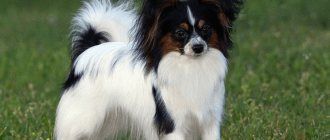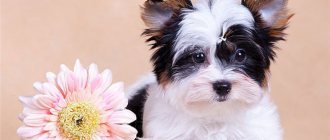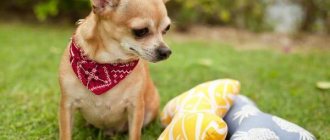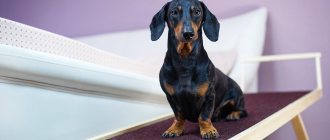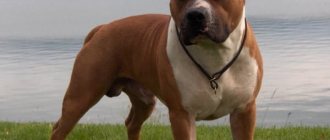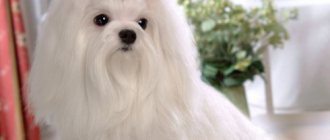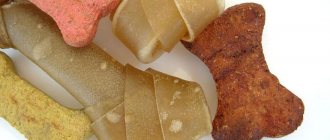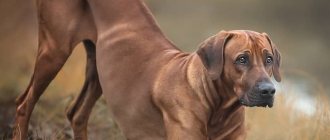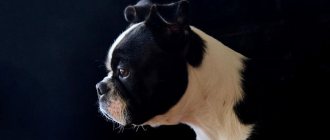History of the Boxer breed
Female and male German Boxer
The ancestors of the German Boxer are bulldogs, mastiffs and bullenbeissers. It was as a result of the mixing of their blood that this breed was born, which began to conquer the world in 1896.
Boxers from the late 19th century and modern boxers are not exactly the same thing. In those early years, they were used as shepherds, for transporting goods and hunting wild boars and bison. Often early representatives of the breed became participants in dog fights and even bullfights. During the First World War, the German army successfully used them as postmen and scouts. At the same time, German boxers also showed themselves as guide dogs. Later, dogs of this breed also revealed their “creative” talents, successfully performing in circus and theatrical performances.
An interesting version is the earlier origin of boxers. Some researchers claim that their direct ancestors are the Tibetan Great Danes, who ended up in Rome and Greece back in ancient times. It is believed that ancient boxers were larger and more aggressive. Their inherent bloodthirstiness helped them cope well with military tasks. They were used for protection and as a baiting dog during the hunt for large forest game, as well as in the popular entertainment of those times - dog fights, which in terms of the intensity of passions were practically not inferior to gladiatorial ones.
Since the end of the century before last, the German boxer began to conquer the world, he had many fans in different parts of the world, who even opened clubs dedicated to this incredibly stately, dignified and beautiful dog. Her appearance seems aggressive (sometimes it may seem that she is ready to rush at a stranger and tear him apart), but behind her lies a good nature and an easy-going character. This is a great merit of the breeders, who did everything possible to add such traits as kindness and balance to agility, endurance and speed of reaction.
When a dog wants to play, it begins to move its paws in the air, as if boxing. This special manner, which makes it unlike other dogs, predetermined the name of the breed. According to the owners' reviews, boxers have all the necessary qualities for living in a family, so they are the best!
Boxer: how to care for a puppy
Cynologists recommend that from the first days of a boxer puppy's appearance in the house, you should start raising it, accustoming the baby to mandatory procedures and exercise. Caring for a Boxer puppy begins at a young age, from the first steps in a new place. The animal must be within the established framework of behavior, get used to a certain way of life and living conditions. This will help the dog develop an adequate and stable reaction to certain manipulations and actions. First of all, this concerns the issue of toilet and diet. The sooner the four-legged pet is shown a way and place to relieve itself, the sooner the little boxer will understand that he is wanted and what to do. The picture with diet looks similar. An established schedule and a constant place of feeding allow you to discipline the dog in this matter.
The toilet for a Boxer puppy in the first months of being in the house is a diaper placed in a certain place. You can get by with other supplies as long as they are cleaned regularly and located in the same place. As soon as the quarantine ends, the first trips to the street begin, the issue with the dog toilet is resolved spontaneously. In order for a young dog to quickly develop the habit of relieving itself outside, walks should be done at the same time, morning and evening. Once you start walking and doing outdoor activities, you will need to take care of your Boxer's coat. There is nothing difficult about this if the puppy is accustomed to brushing and water procedures. For such an active dog as the Boxer, washing its paws and belly after a street walk should become a mandatory ritual.
Food bowls should be placed in one place, where all family members eat. It will be easier for your dog to get used to the fact that there is food waiting for him in the kitchen or dining room.
The puppy requires attention and care. You should not expect that a Boxer dog will be a living toy for your child and other family members. The baby also needs careful and careful treatment. You should not train your four-legged pet to sleep in a bed. Dogs love upholstered furniture and prefer to sit on a sofa or armchair whenever possible. You can solve the problem once and for all by pointing the dog to its place. A soft rug or pillow in a cozy and protected part of the room will become a permanent resting place for the animal. Getting your puppy used to his place will require patience and persistence. Subsequently, the dog will develop the habit of going to its own place to rest on its own.
Features of the German boxer
Boxer puppy
A German boxer at the age of 18 months is already an adult dog, fully developed physically. However, by the age of one and a half years the inner world still remains “childish”. For this reason, attempts to train a dog during a period of his emotional immaturity are practically futile, that is, he does not respond to commands, and the owner even begins to think that he is communicating with a deaf person. But at one fine moment a breakthrough comes in training, and your pet suddenly begins to understand everything that they previously tried to teach him, but in vain.
The Boxer is a sociable dog, it gets along easily with other four-legged inhabitants of the house, but sometimes the cockiness in its character takes over and it begins to chase the yard cats. It happens that a dog of this breed easily gets into fights with other dogs, and fights are often provoked by him himself. By nature, a boxer is a real fighter; he is dexterous, brave and strong. If you train him correctly, you can raise an excellent guard. The childlike spontaneity inherent in a boxer remains with him throughout his life. The dog shows enviable stubbornness, but never achieves his goal with aggression. His main weapon is humor and charm, which no loving owner can resist.
Representatives of this breed have amazing sensitivity, they are very smart and cunning. Sometimes they can be noisy, which is perceived by some owners as a drawback, therefore, in order to develop the best character traits and minimize shortcomings, boxers must be trained. With the right approach to this task, you can achieve amazing results, as boxers perceive training as a game and easily succumb to it.
Running boxer
Dog health
The average life expectancy of representatives of this breed rarely exceeds 10 years. These animals are predisposed to many diseases that significantly affect their life expectancy:
- allergies,
- oncology,
- hip dysplasia,
- hypothyroidism,
- demodicosis,
- heart disease,
- breathing problems,
- deafness.
This is not a complete list of diseases. With proper care and feeding, as well as regular visits to the veterinarian, it is possible to reduce the risk of their occurrence.
Annual vaccinations are required for animals.
Basic vaccinations:
- rabies (12-13 weeks),
- plague, parainfluenza type 2, adenovirosis, parvovirus enteritis, leptospirosis (8 weeks),
- revaccination (12-13 weeks),
- further regular vaccination once a year.
It is not recommended to vaccinate a puppy before two months. Before vaccination, the pet must be absolutely healthy. Deworming must be carried out 15 days before the event.
Appearance and special features of the breed
Boxers have a stocky build. They are also called "square" dogs because their height and length are approximately the same. A wide and deep chest, coupled with a strong back with a slight slope in the pelvic area, is quite consistent with this body type. At the same time, representatives of this breed do not look squat - rather the opposite. The dogs look stately, they have a proud posture, and all thanks to their dry muscles and lean belly. Their limbs are massive, correctly placed, without curvature, so they do not spoil the “figure”. The Boxer's neck is of medium length, strong and muscular, and the tail is long and straight.
Two boxers playing
A distinctive feature of the breed is a slightly protruding lower jaw, a slightly upturned nose and high-set ears - thin, hanging slightly forward. When circumcised (cupping), they acquire a pointed shape, which gives them the correct position. A Boxer's eyes are dark, intelligent, and they can tell a lot about the breed. You can read curiosity in his gaze; it glows with energy, but not with aggression.
The skin of boxers, with the exception of the forehead and cheeks, fits tightly and does not form any folds. The coat is short, hard and also lies tightly. Only two colors are considered classic for German boxers: red and brindle. The first can range from rich red to light yellow shades. The brindle has its own “extremes”: from golden to gloomy dark. The breed standard stipulates that the stripes should appear as clear lines.
Whatever the color, a kind of dark mask is an invariable attribute on the dog’s face. The presence of white markings is acceptable, giving the breed an aesthetic appearance. White, black, gray dogs with a large number of stripes and spots are considered “rejected”. And one more thing: if you plan to send your pet to an exhibition, then docking of the ears and tail will have to be sacrificed. Experts categorically do not recommend performing such manipulations with a boxer.
general description
- The height of the German boxer is average, approximately 60 cm at the withers. An adult dog weighs from 25 to 32 kg.
- Dogs of this breed have superbly developed and voluminous muscles. Their movements are active, energetic, filled with nobility and strength.
- Boxers, despite their “square” physique, have sufficient substance. That is, they cannot be called clumsy, heavy or, on the contrary, too light.
- They are characterized by balance and often serve as guides for blind people.
- Males are larger than females. Pedigree parents can give birth to up to 7 puppies per litter.
Head
The head matches the proportions of the body and, giving the dog a special identity, does not look too massive or too light.
The muzzle, ideally, is as wide and powerful as possible. The correct ratio of the skull and muzzle provides the boxer with a harmonious head. No matter where you look from - front, side or top - the muzzle relative to the skull remains in the right proportion and does not look too small. The Boxer's head is dry, there are no folds or wrinkles on it. The latter are formed, and this is allowed, only in cases where something has alerted the dog. There are natural wrinkles on the muzzle on both sides. But not everywhere, but only in the area from the base of the bridge of the nose down. A black mask is clearly visible against the general background of the muzzle. Despite the gloomy shade, it does not at all impart gloominess to the dog’s appearance.
The upper region of the skull is not wide, not flat and extremely angular. Its shape is somewhat convex, but not shortened or spherical. The prominence of the tubercle in the occipital region is not excessive. The furrow on the forehead (primarily the area between the eyes) does not differ in depth and is only slightly visible. The area from the forehead to the bridge of the nose has a ledge that is clearly visible. The bridge of the nose is not drooped and, unlike bulldogs, it is not turned up.
Boxer muzzle
Teeth
The lower jaw, if compared with the upper, is slightly longer. Its distinctive feature is its upward curvature. The base of the upper jaw is wide, tapering towards the end. Boxer teeth are in excellent health and very strong. The canines are impressively large and widely spaced. The incisors are located on the same line, very evenly. The form of a dog's bite is undershot.
Eyes
Boxers' eyes are rather large, dark in color, not deep-set and not prominent. The edges of the eyelids are also dark. Dogs look intelligently and at the same time energetically, their gaze is kind and does not carry any threat.
Ears
German boxer
They are located on the sides in the upper region of the skull, their fit is high, and their size is proportionate. In a state when nothing bothers the dog, and there is no need to listen to sounds, they are adjacent to the cheekbones. If your pet is alert, the ears will immediately turn forward, forming a clear bend.
Nose and lips
Thanks to the nose, the dog's muzzle has a complete look, its tip is slightly higher than the base. The lobe is slightly upturned, it is wide, the color is black, the nostrils are also wide.
The upper lip is pronounced and fleshy. It covers the free area formed due to the fact that the lower jaw is longer. The upper lip is supported by the lower canines.
Neck
The Boxer's neck is lean, muscular and at the same time round and long (but not excessively). From the mound on the back of the head towards the withers, the upper border of the neck forms a graceful arch.
Frame
The boxer's withers are clearly defined; the body is supported by strong, developed limbs. The back is wide, with a “pumped up” muscular system, but short and level. The croup is slightly rounded, wide, slightly sloping. The pelvis, especially for females, is wide and long.
The chest area is so deep that it reaches all the way to the elbows and is equal to half the height of the dog at the withers. Its front part is powerful and superbly developed.
The underline has an elegant curve towards the ischial tuberosity. The groin cannot boast of length, it is moderately toned.
Tail
Boxer with undocked ears and tail
Has a fairly high seating position. Usually it is not stopped, that is, it is left unchanged - the way it is by nature.
Limbs
If you stand in front of the dog, you can see that the front legs are parallel to each other. The bones of the limbs are strong.
The blades are firmly connected to the body, differ in length and are inclined. The shoulders are also long, located at the correct angle relative to the shoulder blades. The elbows are not pressed too tightly to the chest.
The forearms are also not short at all, they are located vertically and are muscular. The pasterns, on the contrary, are short, almost vertical. The wrists are clearly defined: they are strong, but not too massive.
The front paws have a rounded shape, they are small in size, compact, the pads are hard and elastic. The hind legs are naturally well-pumped, straight, the hips are distinctly wide and long.
Boxing team
The hind legs are slightly longer than the front legs. They are also compact, the pads are hard and elastic.
When the boxer is calm, his knee joints move forward so clearly that they even reach a conventional perpendicular, outlined in the direction of the surface from the iliac tuberosities.
Muscularity is also inherent in the legs. The hock joints, although not massive, are strong and well defined.
Wool
The hair fits tightly to the skin, it is short and hard, and shiny.
Color
Boxers come in red or brindle color. Any shade of the first is allowed, from light yellow to red-brown. The most typical for the breed, or, in other words, preferred, are reddish-red tones.
The brindle color has the appearance of dark or black stripes on a red background. They should be clearly defined and contrast with the background. White areas are not forbidden and, accordingly, are not considered a “defect” of the breed - on the contrary, they can even decorate the dog.
Red boxer
Brindle boxer
Possible defects
Variations that do not meet the breed standards listed above are considered faulty. These deficiencies should be assessed according to their severity and the extent to which they affect the dog's daily lifestyle and health.
Disqualifying faults
The white boxer is considered rare and can cost more than dogs that meet the breed standard.
Physical: congenital bobtail. Behavioral: cowardice or, conversely, aggressiveness.
Defects of the testes: in healthy male dogs, they should be normally developed, completely descended into the scrotum.
Any representative of the breed showing obvious physical defects or behavioral abnormalities shall be disqualified.
Lifespan
A German boxer lives on average 11-12 years. There are happy exceptions to this rule.
Characteristics and description of the Boxer breed
This breed is often found among owners of apartments and private country houses. It has a number of characteristics. Let's talk about this in more detail.
Aggressiveness
The pet easily adheres to all the norms of behavior laid down in childhood. Easily and quickly finds a common language with animals living under the same roof, but shows aggression towards other people's dogs and gets into fights.
Activity
Dogs of this breed are overly active. They require constant attention and daily long walks, which, if possible, should include a variety of loads.
Training
Animal training begins at 3 months of age. They learn easily and understand what their owner wants. With an adult dog things are more complicated. He is less amenable to learning commands. Training will take longer.
Shedding
Boxer shedding occurs seasonally. With proper care there is no smell. The faded fur is not long and can be easily removed from the carpet.
Need for care
Caring for Boxers is not difficult. The main requirement is compliance with maintenance rules and proper balanced nutrition. The puppy must become accustomed to being examined periodically and placed in uncomfortable positions. Such actions should be perceived calmly and without aggression.
Friendliness and attitude towards children
Representatives of the breed are friendly and love children very much. They tolerate all children's intrigues. If the dog doesn’t like something, they turn around and leave. Aggression was not noticed.
They are also good defenders. When letting a child go with an animal, you don’t have to worry, the dog won’t hurt him.
Health
Boxers have a number of health problems. Approximately 20-40% of the breed are born deaf in one or both ears. As you get older, concomitant diseases may appear - hypothyroidism, problems with intestinal function and bloating. Sometimes allergies occur, more often - drinking allergies.
Attitude towards loneliness
Dogs of this breed do not like to be alone. They prefer company and are constantly active, which continues into old age.
Maintenance cost
The costs of keeping pets are not high. They are not picky eaters. They do not require additional maintenance costs; their own corner with a soft surface is enough for them.
Intelligence
Representatives of the Boxer breed are smart and balanced. They learn easily and quickly remember the terrain.
Read Origin and characteristics of the Australian Bulldog breed
Noise
Dogs react negatively to extraneous noise. When there is a loud sound, they rush around the room, sometimes barking. When there is a quarrel in the family, they rub their noses at the owners. But there are exceptions.
Security qualities
Boxers are classified as service dogs. They can serve as guide dogs and can also be reliable guards.
Lifespan
The life expectancy of representatives of this breed is 11-12 years. With good care, a balanced diet and genetic predisposition, the life age can reach 14-15 years.
Photo of an adult boxer
Boxer character
Cheerful, playful, curious, cheerful, energetic - these traits fully characterize German boxers.
These dogs are also loyal, becoming very attached to their owner and his family members. Positive traits stay with a boxer all his life; he likes it when there are a lot of people and noise around him. A boxer who has gone through a good training school gets along well with small family members, treats them with care, never offends them, and plays with them with pleasure. He will not only become an excellent companion for your child, but also a reliable guard.
Boxer with a child
A representative of this breed, subject to good upbringing and social adaptation, will get along well not only with other dogs living in the house, but even with cats. However, the real “temptation” for them is small animals and birds. Your pet can be taught not to touch them, and he will not do this in front of you. But, as they say, it’s better not to leave the boxer alone with them.
The boxer loves to fool around and warmly greets all the people he knows. He never loses his vigilance and therefore will be a good protector for his household. This brave, athletic breed sometimes retains its excellent guarding and guarding qualities until a very old age. In order for the dog not to show his not the best qualities - excessive noise, stubbornness, and sometimes uncontrollability - he needs an owner who will dominate him.
Adults have a calm temperament, which is a direct result of proper training at an early age. The popularity of the breed is precisely due to this very poise, coupled with natural intelligence and tolerance towards people and other pets. The boxer shows the most tender feelings towards his owner and shows with all his appearance that he really likes being around. If you do not cultivate communicative qualities in him, the dog will show suspicion of strangers all his life, bark at them, and refuse to let them near his owner.
The boxer retains his childlike activity and spontaneity until the age of 2-3 years, although physically he matures by the age of one and a half years. Many owners who are not aware of the intricacies of the breed complain that the Boxer does not understand the commands that are taught to him. In fact, it takes time for a dog to learn and retain new information. The owners are then convinced that this is so: at one fine moment the dog begins to do everything that it seemed to have been taught to no avail for a long time.
FCI Standard No. 144 (04/02/2001)
Official translation of the standard Translation from German: Romanenkova E.V. (This translation has not yet been approved by the RKF Standards Commission)
GERMAN BOXER
ORIGIN:
Germany
PUBLICATION DATE OF PREVIOUSLY VALID STANDARD:
13 03.2001.
APPLICATION:
Companion and guard dog.
FCI CLASSIFICATION:
Group 2. Pinschers and schnauzers, Great Danes and Swiss Shepherds. Section 2.1. Great Danes are smooth-haired dogs. With performance tests.
BRIEF HISTORICAL SUMMARY:
The immediate ancestor of the boxer is considered to be the small, or Brabant, bulldog. At that time, the breeding of bulldogs was most often in the hands of hunters, who used these dogs for hunting. The bulldogs' task was to grab the game that the hounds were chasing and hold it until the hunter approached, who would take the prey from under the dogs. For such a purpose, the dog had to have the widest possible mouth with widely spaced teeth in order to properly grasp and hold. Each bulldog possessing this trait was perfectly suited to perform such a task and, thus, also went into further breeding, which previously proceeded only from activity and the need for use.
GENERAL FORM:
The Boxer is a dog of above average height, smooth-haired, dense, square in shape and strong boned. The muscles are dry, highly developed, protruding volumetrically. The movements are lively, full of strength and nobility. A boxer is not supposed to be clumsy or clumsy or appear light.
IMPORTANT PROPORTIONS:
a) The ratio of the oblique length of the body to the height at the withers. The format is square, i.e. the lines limiting the body - and this is horizontal to the back and vertically through the protrusion of the shoulder-scapular joint and, accordingly, tangent to the ischial tuberosity - build a square.
b) The ratio of the depth of the chest to the height at the withers. The chest reaches the elbows. The depth of the chest is half the height at the withers.
c) The ratio of the length of the bridge of the nose to the length of the head. The length of the bridge of the nose relates to the length of the skull as 1:2 (determined from the tip of the nose to the line of the inner corners of the eyes and, accordingly, from the line of the inner corners of the eyes to the occipital protuberance).
BEHAVIOR AND CHARACTER:
A boxer should be of strong nerves, self-confident, calm and balanced. His temperament is the most significant and needs careful care. His devotion and loyalty to his master and the entire family, vigilance and fearlessness of the protector have been known for a long time. He is harmless in the family, but distrustful of strangers, cheerful and friendly in the game, but undaunted in serious matters. He is easy to train due to his readiness to
subordination, courage and courage, natural insight and sensitivity. With its unpretentiousness and cleanliness, it is equally pleasant and valuable in the family as a protective, service dog or companion. His character is simple-minded, without hypocrisy and deceit, the same with age.
HEAD:
It gives the boxer character, should be in good harmony with the body and should appear neither light nor heavy. The muzzle should be as wide and voluminous as possible. The beauty of the head is based on the harmonious relationship between the sizes of the muzzle and the skull.
No matter from which side the head is viewed - from the front, from above or from the side - the muzzle should always be in the correct relationship with the skull, i.e. never seem small. She should be dry, which means not showing wrinkles. However, it is natural that wrinkles appear on the cranial part of the head when alert. Wrinkles, permanently marked, run down from the bridge of the nose on both sides. The dark mask is limited to the muzzle and should be clearly distinguished from the color of the head so as not to produce a stern expression.
CRANIAL PART:
She should be as graceful and faceted as possible. It is slightly arched, neither in the form of a round ball, nor flat on top, nor too wide, the occipital part is not too pronounced. The frontal groove is only faintly marked, it may be particularly between the eyes, but not too deep.
Transition from forehead to muzzle: The forehead forms a clear fracture with the back of the nose. The bridge of the nose cannot, like a bulldog, pass into the frontal part, but without being drawn out.
FRONT PART:
Nose: Wide and black, slightly turned up; wide nostrils. The tip of the nose is slightly higher than the bridge of the nose.
Muzzle: The muzzle shows its massiveness in three dimensions of volume, therefore, it is neither sharp nor narrow, short or shallow. Its shape is influenced by: a) the shape of the jaws, b) the position of the fangs, c) the condition of the lips. The canines should be as widely spaced as possible and of good length, due to which the front of the muzzle becomes wide, almost square and forms an obtuse angle with the back of the nose. In front, the edge of the upper lip lies on the edge of the lower lip. The upward-curved part of the lower jaw with the lower lip, called the chin, may not protrude sharply in front of the upper lip, but gradually disappear under it, but the chin should be clearly visible both from the front and from the side. The canines and incisors of the lower jaw should not be visible when the mouth is closed, and the Boxer should not show his tongue when the mouth is closed. The crack in the upper lip is clearly visible.
Lips: Complete the shape of the muzzle. The upper lip is thick; it fills the cavity created by the longer lower jaw, which is supported by the same canines.
Jaws and teeth: The lower jaw protrudes in front of the upper jaw and is slightly curved upward. The boxer has a good grip. The upper jaw is wide at the base and narrows anteriorly only slightly. Teeth are strong and healthy. The incisors are arranged as regularly as possible in a straight line, the canines are widely spaced and of good size.
Cheekbones: Look consistent with strong jaws, but without emphatic protrusion. Rather, they imperceptibly blend into the muzzle, slightly arching.
EYES: Dark eyes that are not too small, prominent or deep-set.
The look expresses energy and intelligence; it cannot be threatening or prickly. The edging of the eyelids should be dark in color.
EARS: Natural ears are of appropriate size; set on the sides of the head at the highest points of the skull; when at rest they lie close to the cheekbones and hang forward when the dog is alert, with a distinct fold.
NECK:
The top line runs in an elegant arch from the back of the head to the withers. It should be very long, round, strong, muscular and dry.
FRAME:
Square format. The block rests on solid, straight legs.
Withers: She should be marked.
Back (withers to forelock): It, including the loins, should be short, strong, straight, broad and very muscular.
Croup: Slightly sloping, sloping and broad. The pelvis should be long and wide, especially in bitches.
Chest: Deep, reaching to the elbows. The depth of the chest is half the height at the withers. The front part of the chest is well developed. The ribs are well arched but not barrel-shaped and extend far back.
Underline: Runs with an elegant rise posteriorly. Short, tightly padded crotch, slightly tucked.
TAIL:
Set on moderately high. The tail is left natural.
LIMBS
FOREQUARTER: The front legs should be straight when viewed from the front, parallel to each other and of strong bone.
Shoulders: Long and slanting, tightly connected to the block; they shouldn't be very muscular.
Humerus: Long and forming a regular angle with the shoulder blade.
Elbows: Neither pressed very tightly against the chest wall, nor turned out.
Forearms: Vertical, long, with lean muscles.
Carpus: Strong, well defined, but not prominent.
Pasterns: Short, almost vertically set.
Forelegs: Small, round, balled; densely padded pads with hard soles.
HINDQUARTER: Very muscular, the muscles are dense and very prominent. The hind legs should be straight when viewed from behind.
Hips: Long and wide. The angles of the hip-femoral and knee joints are, if possible, slightly obtuse.
Knees: They should be positioned in the stance so that the vertical drawn from the knees to the ground still touches the knees in front.
Lower legs: Very muscular.
Hocks: Strong, well defined, but not protruding. The angle is approximately 140 degrees.
Hocks: Short, with a slight slope from the dog 95-100 degrees to the ground.
Hind legs: Slightly longer than forelegs, in a ball; densely padded pads with hard soles.
MOVEMENTS:
Lively, full of strength and nobility.
LEATHER:
Dry, elastic, without wrinkles.
SHIRT
COAT: Short, harsh, shiny and close-lying.
COLOR: Red or brindle. Red comes in a variety of tones, from light red to dark brown, but mid tones are best (red-yellow). Black mask. The brindle version has dark or black stripes on the main red background of the above shades, running in the same direction as the ribs. The main background and brindles should be clearly distinguishable from each other in color. White markings cannot be rejected in principle; they can even be very pleasing to the eye.
HEIGHT:
Measured from the withers through the elbows to the ground. Males: 57-63 cm. Females: 53-59 cm.
WEIGHT:
Males: more than 30 kg (with a height at the withers of about 60 cm). Females: approximately 25 kg (with a height at the withers of approximately 56 cm).
DEFECTS:
Any deviation from the above points should be considered as a defect or defect, depending on the degree of severity.
BEHAVIOR AND CHARACTER: Aggressiveness, malice, deceit, unreliability, temperamental flaws, cowardice.
HEAD: Flaws in nobility and expressiveness, sullen expression of the muzzle, pinscher or bulldog-like head, drooling, visible teeth or tongue, pointed or light muzzle, drooping bridge of the nose, dry or snotty nose, lightened nose, so-called eyes of a bird of prey, chin, uncropped ears not adjacent to the head, semi-erect or raised ears on cartilage, skewed lower jaw, slanted teeth, incorrect tooth position, tooth protruding beyond the line of the rest, damaged teeth due to disease.
NECK: Short, thick, under chin.
BODY: Too wide and deep at the front, sagging last. Humpbacked back, sagging back, protruding ridge, long narrow loin with sharply protruding hips, poor connection to the croup, domed loin, sloping croup, narrow pelvis, drooping belly, abdominal area, sunken groins.
TAIL: Low set tail, kinked tail.
FOREQUARTERS: Broad, loose shoulder blades, loose elbows, bad wrists, hare foot, flat, splayed foot.
HINDQUARTERS: Weak muscles. The angles of the joints of the hind limbs are too weak or too pronounced, and the metatarsals are sloping under the dog. Barrel-shaped stance, Korovina, narrow metatarsal stance. Dewclaws. Russian paw, loose paw.
MOVEMENTS: Rocking from side to side, short step, ambling, linked movements.
COLOR: The mask extends beyond the muzzle. Tiger spots that are too densely located or only noticeable in places. Blackened main background. Unlimited colors. Unsightly white markings, namely a completely or half white head. Other colors or those where white occupies more than one third of the total body surface.
NOTE:
Males must have two apparently normally developed testes, fully descended into the scrotum.
Training and education
Boxers are smart, well-trained dogs. At the same time, they are stubborn and perceive new information selectively. They refuse to carry out many commands, preferring to obey only those that they like.
High five!
Some owners believe that training a representative of this breed needs to be done using the “carrot and stick” method, that is, punishing for disobedience and rewarding for precise execution of commands. However, the “whip” in this technique will be superfluous, since boxers react poorly to punishment. Various incentives (praise, treats, awards) make them more receptive to training. By using a specific set of commands, you are sure to achieve excellent results during the training process. With the correct and clear formulation of tasks, the boxer remembers the learned commands for a long time.
Boxer training usually begins from the moment the puppy is in the house, and full training begins from three months. First of all, the dog is taught basic commands, such as “Sit!”, “Lie down!”, “Near!”. When your pet has mastered them, you can begin teaching the “Come to me!” command. This command is considered the main one; the boxer must perform it in any situation and the first time.
The Boxer loves the outdoors very much, so the countryside suits him perfectly. But even in an apartment, your four-legged friend will feel good if you regularly take him for walks in a large park, where he can take long walks. The dog will be an excellent companion for an owner who loves morning or evening jogging. He is ready to spend the whole day outdoors.
Dogs of this breed are often left to frolic in the courtyards of houses, first making sure that the fence is strong. The latter is not out of place: there are many cases where German boxers jumped over the fence and ran away. Their jaws are so powerful that, if left alone at home, they can even bite through the lock on the door.
Maintenance and care
It should be noted that representatives of this breed must live indoors. These dogs have very short hair, so they heat up and cool down quickly. Due to this feature, it is recommended to place the German Boxer's bed away from the operating air conditioner and from direct sunlight.
Since Boxers have a lively, active temperament, it is recommended to walk them at least twice a day. Moreover, the duration of each walk should be at least forty minutes. If possible, once a week it is advisable to take your pet to the forest or to a park, where he can frolic to his heart's content. For winter walks, the dog must purchase a special overall that provides reliable protection from frost.
As for care, the German Boxer, whose photo can be seen in today’s article, is considered one of the most unpretentious dogs. His short coat does not require frequent brushing and washing. In case of heavy contamination, simply wipe the animal with a damp towel.
To avoid inflammation of the ears and eyes, hygiene procedures should be performed in a timely manner. About once a month your dog needs to have its nails trimmed. It is recommended to use a special device for this. You should also pay attention to your pet's oral cavity. At least once a week you need to brush your dog’s teeth and examine his gums. If redness is detected, the animal must be shown to a veterinarian.
Care and maintenance
Wherever you place your pet, in an apartment or a country house, it will fit in perfectly everywhere. He will be comfortable even in an ordinary kennel, but on the condition that another dog shares this “living space” with him.
In general, German Boxers are quite easy to care for, but they do not tolerate cold and high humidity well.
Since Boxers have short hair, it, unlike long-haired breeds, does not get tangled or tangled, and therefore does not need frequent combing.
Frequent bathing is not recommended for Boxers. If your pet gets dirty during active play, simply wipe the dirty area with a damp cloth.
Since a boxer is very active by nature, a sedentary lifestyle is contraindicated for him, he must receive maximum physical activity. For the healthy development of a dog of this breed, a balanced diet is also required.
The dog's eyes require special attention. Tear secretions or dust often accumulate in their corners, and a soft handkerchief is enough to remove them. If your dog's eyes are red, a soothing ointment will help. However, do not self-medicate: the drug must be prescribed by a veterinarian.
Dirt may accumulate in the ears. To remove wax and dust from the ear, just wipe it with a handkerchief wrapped around your finger or wipe it with a damp swab. Cleaning a Boxer's ears with a cotton swab or putting alcohol in them is strictly prohibited.
A boxer's claws should not touch the floor when walking. Otherwise, they need to be cut off. For this purpose, special forceps are used. The procedure should be carried out no more than twice a month, otherwise you will cause discomfort and pain to your pet.
Boxer in the apartment
Breed standard
German Boxers are medium-sized dogs. Representatives of the breed are characterized by a stocky build, dry muscles with a clearly protruding relief under the coat. Males weigh from 27 to 32 kilograms, height at the withers is up to 63 centimeters. Bitches are more miniature: weight 25-29 kg, height - 53-60 cm.
Appearance characteristics:
- The head is compact, square with a massive protruding forehead. The muzzle is flattened, with a dark mask.
- The nose is upturned, black with wide nostrils.
- The eyes are small, almond-shaped, dark.
- The jaws are powerful. The lower one protrudes forward, which gives the dog a warlike appearance. The teeth are strong and symmetrically spaced. The form of the bite is an undershot.
- The lips (brows) are thick and fleshy.
- The ears are set high.
- The body is square, the loin and back are strong and short.
- The limbs are correctly placed and massive.
- The croup is wide, the belly is lean, fully tucked.
- The coat is short, hard, lying close to the body.
- The skin is dry, elastic, without wrinkles.
According to the standard, German boxers have two colors - brindle and red. Grey, black and others are considered defective. White markings on the coat are allowed and give the exterior a more aesthetic appearance.
Boxer health and illness
Two boxers on a leash
Despite the fact that boxers are given 11-12 years of life by nature, on average they rarely live to be 10 years old. The reason lies in a weak immune system. Because these dogs are uncomfortable in cold temperatures, they are prone to hypothermia, colds and allergies. To ensure that their health is not endangered, the premises in which German boxers are kept must be dry and draft-free. In wet and windy weather, it is better to refrain from walking.
The most common diseases of this breed include the following: heat intolerance, allergies, deafness, benign and malignant tumors, stomach torsion, hypothyroidism (decreased thyroid function), arthritis, heart problems, dysplasia (hip and elbow), degenerative myelopathy ( As a result of this disease, paralysis of the lower limbs is possible).
Education and training
This simple task requires patience. At the very beginning, you need to pay attention to working out the basic standard commands and only after that you can begin special training.
It is advisable to work with an animal from the first days after its appearance in your home. First of all, German Boxer puppies must learn to respond to their name. After the little pet remembers its own name, you need to move on to learning basic commands. At first, you should not overload the animal too much, as the puppy quickly gets tired and begins to get distracted. The first lessons can be conducted in a playful way.
During the training process, you need to take into account that some individuals are characterized by increased stubbornness. Therefore, it is advisable to begin active training with puppies of this breed as early as four months of age.
How to choose a puppy
In addition to meeting the breed standard, an important criterion for choosing a future pet should be whether its character matches yours. You must also initially decide for what purpose you are choosing a German boxer. If your goal is not for your dog to participate in various exhibitions and you just want to engage in breeding, a sociable companion dog will be just right. The puppy should show his playfulness, friendliness and desire to communicate with you.
Mom and boxer puppy
The Boxer is perfect for active, cheerful people, because it is a sporty dog. Even if you choose a “not elite” puppy, communicating with him and training him will bring a lot of pleasure. Running for many kilometers is not a problem for him; he will keep you good company on hikes and excursions to hard-to-reach places.
Many people would like to become boxer breeders in order to sell puppies in the future. For this purpose, do not skimp on a good bitch, which will become the starting point for breeding. She must meet the following criteria: be a descendant of a famous family with excellent titles. In order not to make a mistake in choosing, it is better to purchase a breeding puppy from well-known nurseries, which guarantee that you are not buying a “fake”. You should also pay attention to the qualities of the puppy’s parents: they must have excellent characteristics inherent in this breed and be mentally balanced.
You should definitely inquire about the health of your future pet, whether he has been tested for spondylosis deformans, hip dysplasia, behavioral abnormalities and eye diseases. Any of these ailments poses a real danger to Boxers and can even cause the death of the dog. It would be a good idea to request from the breeder a document that records the results of the litter examination in order to find out how many puppies the commission rejected. If the number of such defects turns out to be high, it is better not to adopt a puppy, as there is a risk of transmitting defects to offspring.
Description and characteristics of the breed
This breed was developed by German breeders in the 19th century in Germany. The main ancestors are two currently extinct breeds, Bullenbeitzer and Berenbeitzer. The first ones were used for baiting bulls in battles and had incredible grip and strength.
Berenbaitser were excellent hunting dogs and were used to hunt bears and wild boars. Another “relative” of the boxer is the English bulldog, who had incredible fighting qualities. As a result of careful selection and breeding, the first boxer registered in the breed register, Floki, appeared.
The first breed standard appeared in 1902.
Appearance can be characterized by a muscular, strong build, a square body and a powerful chest.
Boxer breed standard
- Height at withers: males – 27-30 cm, females – 25-27 cm.
- Weight: females - 25 kg, males - 30 kg.
- Head: large, proportional to the body.
- Muzzle: shortened (brachycephalic type of skull), a clear transition from the forehead to the nose, pronounced jowls.
- Eyes: dark, not protruding, dark pigmented mucous membrane.
- Nose: upturned, wide, black.
- Ears: Set high, close to the cheekbones.
- Neck: muscular, not very long.
- Teeth: characteristic of the breed is undershot.
- Limbs: front limbs are smooth, straight, massive, rear limbs are strong and muscular.
- Tail: Set high, straight, of medium length.
- Coat: short, hard, shiny.
- Color: red, brindle, light yellow, brick brown, red brown. With a brindle color, the stripes should contrast well with the main shade, there should be a dark “mask” on the face, white spots are acceptable, but should not occupy more than a third of the body surface.
- Movement: energetic.
- Life expectancy: 11-13 years.
2002, docking the ears and tails of these animals is prohibited by the standard.
This innovation caused a lot of controversy, since docking is a standard procedure used for many breeds, radically changing the appearance of the dog.
Disadvantages, or deviations from the standard, include: too small or large head, uncovered incisors and fangs with a closed mouth, unclear “mask,” sluggish movements.
Photos of boxer puppies
How much does a boxer cost?
Boxers are relatively inexpensive and can be purchased in almost any region of our country.
You won’t have to look long for puppies of the “show” and “breeding” classes. You should treat your future purchase responsibly and thoroughly study the breed standard so that you don’t end up being deceived when making your own choice. Those who lack experience and knowledge are advised to seek advice from specialists. The cost of a German boxer is influenced by factors such as conformation, age and origin. You can purchase a puppy from private breeders for 3,000 rubles. Only he will be without a pedigree: from the documents it will be possible to obtain only a veterinary passport.
Puppies from purebred parents, which have, in addition to a veterinary passport, a brand and a puppy card, are more expensive - from 8,000 rubles. Be sure to pay attention to the contents of these documents. The veterinary passport must contain notes on vaccinations and parasite prevention. Do not forget that all necessary vaccinations for a puppy are given between the ages of 2 and 3 months.
A puppy card is like a metric for a child; based on it, you will receive a pedigree for your pet in the future. Each such card contains the following data: date of birth, information about parents, which breeder it was purchased from, coat color, brand number and nickname. The mark is placed on the ear or groin area at the time of sale. A puppy card is a very serious document. Without a certificate of inspection of the puppies by the breeding commission, which includes authorized dog handlers, it cannot be issued.
Inexperienced owners are advised to be in close contact with the breeders and consult with them. Specialists who care about their job will never refuse advice and will try to help in solving possible problems with the puppy at the stage of their occurrence. This will help the boxer develop properly, learn to get along with his owners and explore the world. And how your pet will grow up depends only on you.
